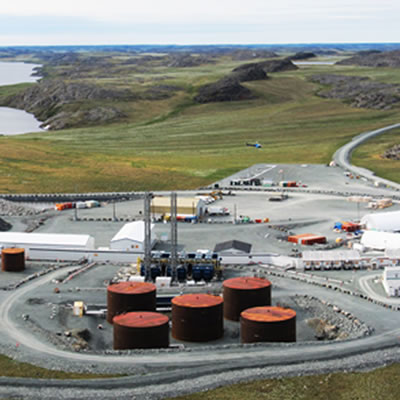TMAC Resources: Hope Bay Gold Mine project moving successfully along the “path to production”

TMAC Resources reports that the company remains on track and on budget for reaching production of their Hope Bay Project at the end of 2016. — Photo c
TMAC Resources reports that the company remains on track and on budget for reaching production of their Hope Bay Project at the end of 2016. — Photo courtesy TMAC Resources
TMAC Resources reports that the company remains on track and on budget for reaching production of their Hope Bay Project at the end of 2016.
Dr. Catharine Farrow, Chief Executive Officer of TMAC, stated, "We are pleased with our progress in moving the Hope Bay Project along the path to production. The third quarter of 2015 was our first quarter as a TSX-listed, fully-financed, gold development company. During the quarter, we significantly de-risked the Hope Bay Project financially by securing equity and debt financing for gross proceeds of over $350 million."
"In addition, we continued test mining underground at Doris, commenced construction on the foundations for the mill building, shipped the mill building components to site, and continued our work with Gekko Systems of Australia to execute on the procurement, fabrication and testing of the processing plant for shipment and installation during the third and fourth quarters of 2016. We remain on track and on budget for reaching production at the end of 2016."
THIRD QUARTER HIGHLIGHTS
Hope Bay Project
In the second quarter of 2015 Gekko Systems Pty Ltd of Ballarat, Australia ("Gekko") was engaged to engineer, fabricate and prepare for shipping a processing plant (the "processing plant"). The flowsheet design was completed and fabrication commenced. To the date of this news release the processing plant detailed engineering is 88% complete, the procurement, fabrication and factory testing is 22% complete, and it remains on budget and on track for shipping early in the third quarter of 2016.
Completed the 2015 sealift including the purchase and delivery to Hope Bay of:
- underground mobile mine equipment capable of mining at a rate of 1,000 tonnes per day;
- 15 million litres of diesel fuel;
- the building that will house the processing plant (the "mill building") to allow for erection of the building in the second and third quarters of 2016; and first year mining parts and supplies.
- Initiated on site construction of the foundations for the mill building.
- Developed a narrow vein undercut test drift at Doris to validate the mining model and cost assumptions in the PFS.
- Widened the Doris mine vent raise and installed an escape-way.
- Increased underground development activities in September with the arrival of the underground mobile mining equipment noted above.
Development Highlights:
Doris Underground
- The fleet of underground mining equipment was delivered to site in the 2015 sealift and was commissioned in preparation for mine operations.
- Mining crews began extracting a test stope in Doris in order to validate planned mining methods and increase management's confidence in the assumptions for the mining costs in the pre-feasibility study, with an effective date of March 31, 2015 , (the " PFS "). The crews were able to achieve a stope width of less than one metre because blast vibration monitoring enabled the crews to refine the drill pattern and blast timing design. The importance of this result is that it reduced the number of tonnes in this particular stope from an estimate of 1,600 to 650 and increased the estimate of the grade from 13 to 31 grams per tonne due to less dilution. Additionally, this resulted in the consumption of less explosives when compared with the amounts assumed in the PFS. The lessons learned in drift and stope over-break control from the mining conducted in the test stope are being applied to the 2015 and 2016 mine plans to reduce mining dilution and improve head grades.
Site Construction and Support Activities
- The sealift delivery of 15 million litres of diesel fuel was successful. Seven million litres of diesel fuel have been transferred from TMAC's tank farm at Roberts Bay to the Doris fuel tanks to support a full year's operations. Five sealift transfers included the fuel noted above, surface and underground mobile equipment, mining supplies, spares, explosives and the structural steel and panelling for constructing the mill building. In addition, widening and lengthening of the airstrip started. Currently measuring 3,000 feet or just under 900 metres, the plan is to increase the airstrip's length to 1,400 metres and double its width to 40 metres giving TMAC access to larger aircraft when chartering airfreight and for moving personnel in and out of site.
- Innovative Steel ("IS") of Vancouver, BC completed the design and fabrication of the Mill Building. TMAC management's coordination of Gekko and IS, which began in November 2014, has helped to advance the project toward mill building erection and processing plant installation at site in 2016. The foundations for the mill building are 83% complete and are on track to be largely finished by the end of November. With average daily temperatures dropping, the remaining concrete pours require insulation and heating to cure properly. This was anticipated and the transition to cold weather pouring has gone smoothly. The current plan, weather dependent, is to start erecting the mill building itself in April 2016.
Processing Plant Engineering & Fabrication
- The test work for Madrid ores was completed in the first quarter of 2015, included in the PFS and incorporated into the design of the processing plant to ensure it meets the long-term requirements of the various ore types identified in the PFS. Gekko has completed the system design. Processing plant detailed engineering is 88% complete, and the procurement, fabrication and factory testing is 22% complete.
- The processing plant is to be delivered during the 2016 sealift. Planning for the installation and commissioning of the processing plant is in progress.




